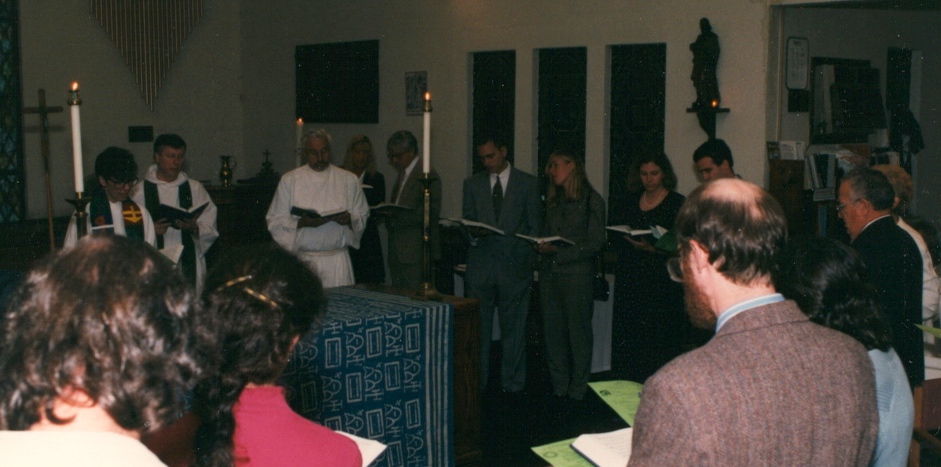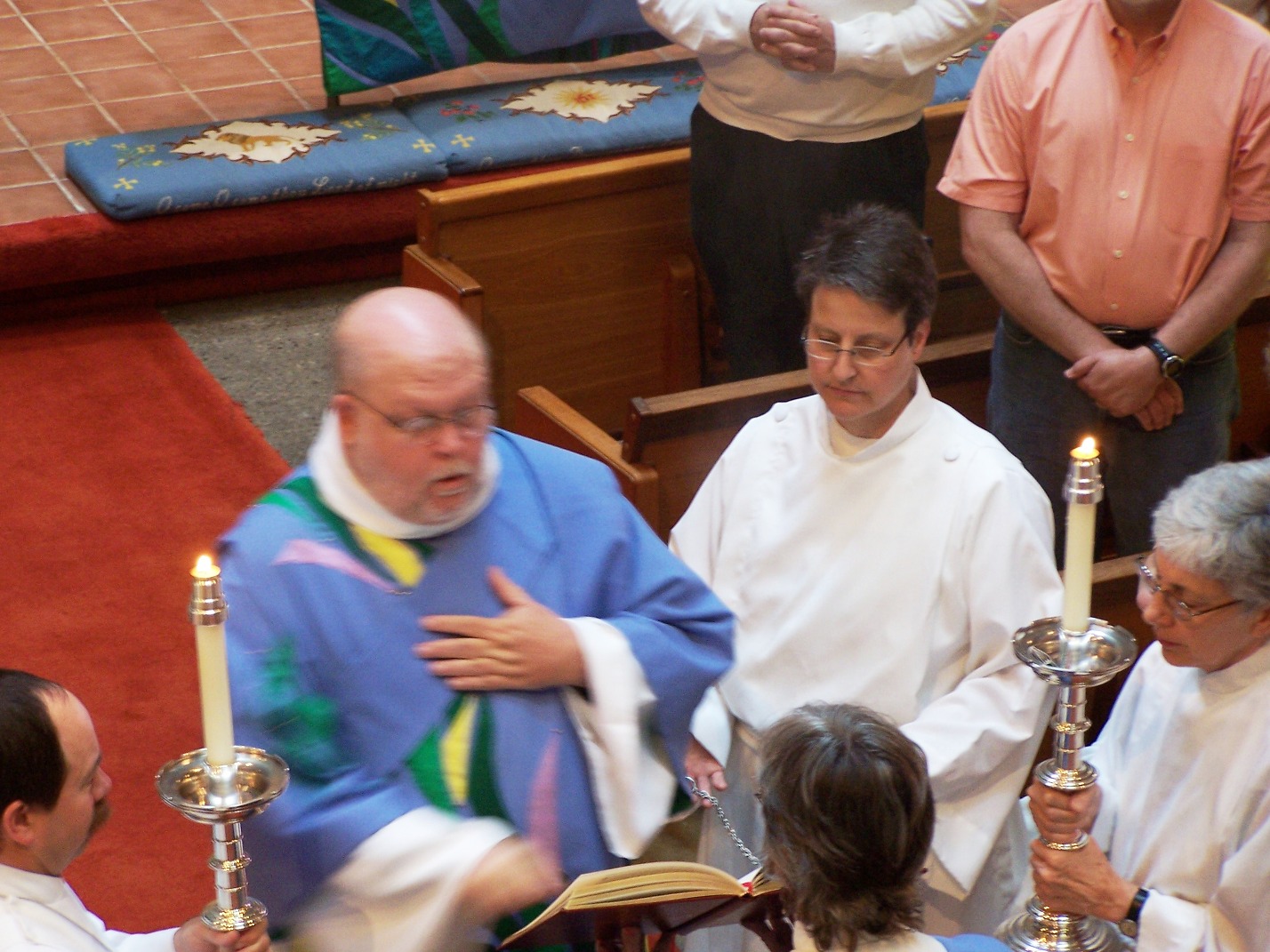 There were two congregations in the parish
There were two congregations in the parish
At 8:00 the Eucharist was Rite One, people sitting in pews, no physical exchange of the Peace, everyone was retired. It was a said service with no hymns. All fairly traditional.
At 10:00 there was a community that gathered in the round, had a shared sermon, used Rite Two (with slight modifications), was deeply involved in the city’s life, and was given to the spirituality of Julian of Norwich. Rather innovative, maybe a bit quirky, all in all.
Each had its own life. The 8:00 people had known one another for a long time. They would go for breakfast together after the Eucharist. The 10:00 congregation had sub groups – more liberal and more conservative; some seeking the silence and centeredness, others the passion about the city’s issues; there were the jazz people and the catholic liturgy people.
As they transitioned to this way of being one parish together the two congregations had gone through a process in which the integrity of each was respected and built upon. When issues were tested, surveys done, and group conversations held – it was mostly done as two congregations. That allowed each to have a good bit of control over their worship and community life.
Occasionally, a person or two, usually from the ten o’clock, would want to bring the two congregations together. Those people had a view that there was one congregation not two. All such attempts were repelled.
That way of being a parish has pretty much been the norm in Episcopal parishes for many years. An early said Eucharist often Rite One and a later Rite Two with hymns and music. Two different psychological contracts in play. Some may attend the other liturgy on occasion. But it’s rare.
The pressure about “community”
It’s easy for inexperienced parish leaders to get confused about all this. Often there are a few people who want to know everyone. Or they say they do. They’ll pressure leaders to reduce the number of masses. They rarely know everyone in the congregation they attend very well. So, it’s hard to understand what drives them. Maybe it’s that they have become bored with those they worship with week-by-week. Maybe it’s a utopian idea about there being a way for larger groups of people to all know one another well. Maybe it’s a notion of “community” that is grounded in intimacy.
Leaders will also find that many, maybe most, people if asked about getting to know people from the other congregations, will say that’s a grand idea. We are still generally polite about such things. One parish profile included a goal, “To help facilitate a sense of unity and community so that parishioners feel connected to the parish as a whole." However, if the question or goal is made more concrete – how much time to spend together, the impact on your Sunday morning, and so on – usually we find the investment to be rather low. The goal statement mentioned above is from a parish profile in which there are many more statements highlighted that indicate people felt a strong connection to the parish as a whole. It appears that no one noticed the contradiction or if they did, it was explained away.
There is also at times pressure coming from a rector or warden because their best experiences were in smaller churches. Or they are more skilled at leading smaller parishes with fewer congregations.
When you are dealing just with an 8 am and 10 am there is usually no pressure to collapse the two into one Eucharist. It’s in the somewhat larger parishes where there are three Eucharists each Sunday morning that you’ll see pressure to collapse the second two. That usually goes no place unless the parish begins to decline in average attendance. At times it will be necessary to bring the two congregations together into one. But often the pressure to do that is premature.
Empowered community
The most effective way to create empowered communities within a parish is to appreciate the uniqueness of each congregation. It’s true both in smaller and larger parishes.
Some parishes head off the pressure to collapse congregations by stating a truth – It may be said this way, “As we have grown, we have had to face the fact that we as individuals can no longer know or recognize everyone in the parish. Occasionally we may have an embarrassing moment if we welcome as newcomers people who have been around for a long time.”
How do you empower each congregation? That’s done by developing strong communities around each Eucharist. Have a coffee hour after each liturgy that fits that group. So, if the 8:00 congregation is open to staying around for a cup, keep it short, maybe do it in the narthex. The 9:30 congregation may like a rather full event. Adequate time to spend socializing, good snacks. The 11:15 may prefer a shorter coffee hour. In general you'll develop a stronger sense of community if you avoid trying to organize the time in between services. Allow people to spend time with one another. It will be much more empowering than filling the time with programs.A parish in Chicago has a lay member serving as a community developer for each of the larger congregations. That person makes sure coffee hour goes well, arranges times for those who want more contact to gather monthly for a brunch, sets up a book group for those interested.
Some will resist strengthening each congregation and keep up the pressure to merge congregations. They may talk about creating more “energy” by bringing together a larger number of people. Most experienced clergy know that “energy” is a more complex matter. The 8:00 am mass may just have 15 people in a space that at 10:00 will have 75. Yet, the energy at 8:00 is fine. The rhythm and pace, the expectations of how things will feel, all add up to a productive “energy.” Matters of energy, vitality, strength are not just about numbers of people in a space. The expectations people bring along with issues of grace and flow will have an effect. The rhythm between silence, said elements and sung elements will impact “energy.”
 Unafraid to express that identity with grace and confidence in its liturgy
Unafraid to express that identity with grace and confidence in its liturgy
Finally, in most parishes it is what happens in the liturgy that will be the critical force in the shaping of true community.
Mary Gray-Reeves and Michael Perham in The Hospitality of God wrote this about Saint Paul’s Seattle:
As a visitor to this congregation, it was easy to be swept up to fully participate in the liturgy because it was confident, well done and a genuine expression of the spiritual life of the body. It was simply true. This congregation was reportedly half its current size just five years ago. While offering satisfaction for the postmodern’s yearning for mystery, from the moment one first read the bulletin – which stated ‘if you are unfamiliar with the ritual customs of The Episcopal Church, simply relax with the liturgy and let the rest of the congregation carry you in worship’ – it was obvious that this community had a clear understanding of itself and was unafraid to express that identity with grace and confidence in its liturgy.
rag+
Shaping an empowered parish community: Part One
Shaping an empowered parish community: Part Two
Shaping an empowered parish community: Part Three